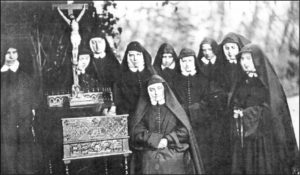
BY CAROL BAASS SOWA
TODAY’S CATHOLIC
SAN ANTONIO • The family tree of early 20th-century architect Fred Gaenslen, covered in the July 6th issue of Today’s Catholic, contained many a noteworthy ancestor who made their impact on San Antonio’s history. His grandaunt (sister of early San Antonian Ralph Peacock/John Bowen and great-great-grandaunt of present San Antonian Thomas “Tommy” Adkisson), however, is on the path to outshining them all internationally — and beyond.
Cornelia Augusta Peacock, born into a prominent Presbyterian Philadelphia family in 1809, blossomed into a typical Victorian-era young woman. Described as attractive, lively and well-educated, she was orphaned at 14 and had been living with her half-sister when she fell in love with an ambitious and charismatic young Episcopalian cleric, Pierce Connelly. Her sister disapproved of the marriage, resulting in Cornelia moving in with a more sympathetic sister and marrying him in 1831.
Pierce became rector of a Mississippi church, and two children were born to the happy couple. Four years into their marriage, however, Pierce experienced a crisis of faith, resigned his position and announced his intention of becoming a Catholic. Cornelia was at first hesitant to accept this, coming from an anti-Catholic background, but the more she learned about the Catholic faith, the more she too desired to convert to Catholicism. In fact, she was formally received into the Catholic faith before her husband was, in New Orleans’ St. Louis Cathedral. He had set his sights on meeting the pope and becoming a Catholic in Rome, the center of Catholicism, and did so during their extended stay there, which included an audience with Pope Gregory XVI.
A loss of family fortune necessitated their finally returning to America, where they lived on the grounds of a convent in Louisiana while Pierce taught at a Jesuit Catholic college. Two more children were born to them, but one died when only a few weeks old, and the other, a toddler, expired in his mother’s arms, following a tragic accident.
After attending a retreat in 1840, Pierce announced to the then pregnant Cornelia that he felt called to the Catholic priesthood. Stunned, but wanting to do God’s will, she agreed to this, after much prayer, though she deeply loved her husband and it would mean their separating. Although she did not feel called to be a nun, she went to live in a community of Sacred Heart sisters, along with their two younger children, the eldest being off at boarding school. (Her sister, Mary Frances, had converted after Cornelia and was already a Sacred Heart novice.) Meanwhile, Pierce sailed for Europe, hoping to work towards a dissolution of their marriage by the pope. He took a job as a tutor in England and placed their oldest son in a boarding school there.
When the pope required husband and wife to jointly appear before him for the momentous request, Pierce returned to America, bringing back his wife and children to live with him in England. Surprisingly, perhaps swayed by Pierce’s charismatic devoutness (which had originally won Cornelia’s heart), the pope did grant a Deed of Separation and within a year Pierce was ordained, while Cornelia became a postulant in an Italian Sacred Heart convent, taking with her the two youngest children.
Recognizing abilities in Cornelia she did not originally see in herself, Pope Gregory eventually dispatched her to England to fill the need for Catholic schools thereby founding a new teaching order of sisters. She chose for its name Society of the Holy Child Jesus. Under her patient and courageous leadership, the Sisters of the Holy Child Jesus struggled through adversities to do tremendous good in their work among the poor in an often anti-Catholic environment. Over the years, they sent sisters throughout the United States, founding convents and schools there, as well as in Europe, South America, Latin America, and Africa.

Sadly, Pierce’s aspirations of achieving success in the priesthood did not come to pass. He grew embittered, left the priesthood and the church and publicly railed against it. Along the way, he falsely tried to claim authority over Cornelia’s order, purporting to have cofounded it and seeking through hierarchical channels to have his newly written constitutions pre-empt hers. At one point he attempted to force Cornelia to return as his wife, taking their children away from her and bringing his case before a British court of law. Fortunately, the original ruling in his favor was overturned.
The long-suffering Cornelia held firm to her commitment to God’s work and the Sisters of the Holy Child Jesus through it all, despite still caring for the man she had wed so long ago and her intense grief at her children being taken away by him and turned against her. In later years, she remarked the order had been founded on a breaking heart — hers when she first sacrificed her natural happiness by permitting Pierce to break up their family and home. Once she had given her broken heart to God, however, she did not take it back.
Opinions vary as to Pierce’s case being one of longstanding impulsivity and misguided zeal or that of a temperamentally unbalanced mind. An early children’s book on Mother Cornelia’s life, The First Holy Child Nun, may sum it up best. Its uncredited author reminds us to pray for Pierce Connelly, as we should for all sinners, and not forget the good he did in his years as a priest. “Perhaps,” it reads, “when he died in Italy in 1883, God gave him the grace to be really sorry for all his sins.” Mother Cornelia is said to have continued to pray for his soul.


